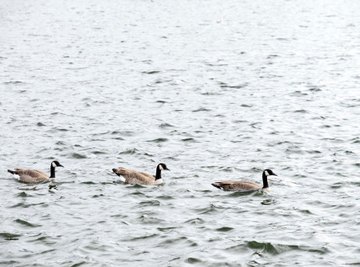
Individual ecosystems serve as balanced communities. From lions to bears and ants to whales, all animals have their own role and contribution to their community. Ecosystems vary drastically, especially in size, and consist of diverse species living and interacting with each other and their environment.
Tundra Ecosystem
Located in the Arctic and Alpine regions, tundra ecosystems have the coldest environments, with temperatures ranging as low as -70 degrees Fahrenheit. Not many plants and animals are capable of bearing the extreme conditions in a tundra ecosystem. Some animals found here adapt to this environment by growing long thick furs to insulate heat. The arctic fox with its short legs, furry feet and bushy tail feeds on dead animals and rodents. It lives in the tundras of North America and Europe. Polar bears adapt well to these extreme conditions with their thick layer of fat and fur. They mostly hunt seals and other sea mammals.
Grassland Ecosystem
Grassland ecosystems include prairies and savannas. Grasses cover most of the land with only a few or no trees at all growing in the region. The abundance of grass and vegetation makes it a good home for herbivores. Mammals – such as the rabbit and deer – feed on plants, as well as insects like the monarch butterfly and swamp milkweed leaf beetle.
Desert Ecosystem
These ecosystems experience little or no rainfall and extreme temperatures – often soaring close to 130 degrees Fahrenheit on the hottest days. Many plant and animal species learned to adapt to these ecosystems despite the harsh environment. “Crepuscular” animals, such as the rattlesnakes and the gila monster, survive the extreme heat in the desert by being active only during twilight-dusk and dawn. Other animals, such as the camel, learn to go long periods of time without water.
Pond Ecosystem
Even simple ponds have a complex ecosystem. This consists of plants as the primary producers; as well as “consumers” who are “heterotrophs”; and finally decomposers, or “detritovores,” that feed on dead and decayed matter. Pond animals include:
- frogs
- fishes
- birds
- snakes
- insects
- turtles
- microscopic organisms
Survival of animals here depends largely on the production of plants. Heterotrophs feed on plants and other animals while decomposers act on decayed matter to make raw materials for the primary producers. This ecosystem survives with the continuity of this basic cycle.
References
About the Author
Steve Johnson is an avid and passionate writer with more than five years of experience. He's written for several industries, including health, dating and Internet marketing, as well as for various websites. He holds a bachelor's degree from the University of Texas.
Photo Credits
Jupiterimages/Comstock/Getty Images
